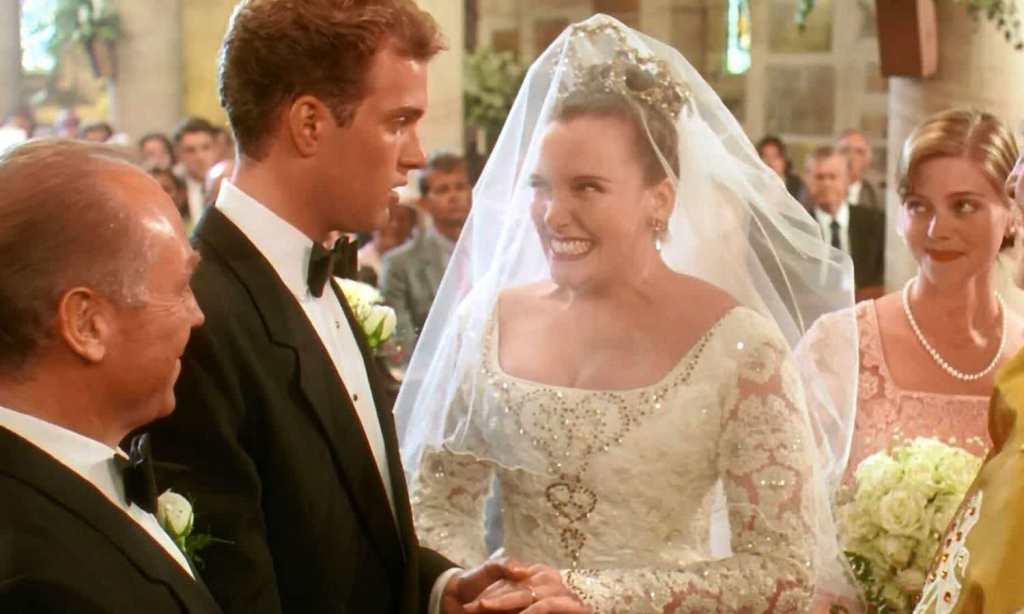“You’re terrible Muriel” is by far one of the most well-known lines to be uttered in an Australian film and if you didn’t feel old already, the hit movie Muriel’s Wedding (1994) from whence it came, is turning 25-years-old in March.
Starring Toni Collette as Muriel Heslop and Rachel Griffiths as her best friend Rhonda Epinstalk, the film not only became a cult watch but was a springboard to their hugely successful careers.
In honour of the 25th anniversary of the feature film, Aussie filmmaker P.J. Hogan spoke to US entertainment site Variety about why it’s premise is still “relevant” today.
“It’s still very relevant — even more so,” Hogan told the outlet. “It’s all about self-esteem.”
Collette, who played social outcast Muriel told Variety that “most people feel like an awkward outsider at some point in their lives”.
“It’s a part of being human. Insecurity amongst other hurdles exists to be overcome. I am realizing audiences were generally comforted by Muriel.”
“It still makes them feel less alone,” Collette said while making it “OK about feeling vulnerable and imperfect in a society that demands so much of us.”
The story centres around Muriel Heslop who lives in the quiet Gold Coast town of Porpoise Spit with her bully-of-a-father, a local politician Bill Heslop (Bill Hunter), her softly-spoken mother Betty (Jeanie Drynan) and brother and sister, Perry (Dan Wyllie) and Joanie (Gabby Millgate).
And while her family are happy to live a some-what ignorant existence (while making Muriel the butt of every joke) the ABBA-obsessed Muriel aspires for something more.
Wanting nothing more than to get married, she embezzles money from her family, goes on holiday and meets Rhonda, another social outcast from her town. Before long, the pair move to Sydney — without her family’s knowledge.
WATCH NEXT: The official trailer of Muriels Wedding. Story continues after video…
The film was both written and directed by Hogan (and produced by his wife Jocelyn Moorhouse) and was based on his sister.
“I was the oldest. My sister and I both had a fractious relationship with our dad. In fact, he was an absolutely bully, way worse than the bully in the movie,” he said during the interview.
In fact, the entire storyline about Muriel embezzling money from a cosmetics line and her disappearance actually happened.
“Everybody was so angry at her, but I understand why she did it,” he said.
Hogan asked his sister for permission to make the successful film, but she only agreed on two conditions: “The first was she would be the heroine in the story and the second was that I would not use her name.”
While it was a hard slog to get anyone to invest in the film (mostly because Muriel was “unsympathetic”), Hogan and Moorhouse “believed in it and kept going”.
Hogan had gone to school with Australian writer Jane Campion, who had just won an Academy Award for her screenplay of The Piano (1993) starring Holly Hunter and Anna Paquin and had been produced by the long-defunct French company, Ciby 2000.
“I called Jane and said ‘Look, the script’s going to this French company who don’t know who I am. Could you put in a good word for me?’”.
And thus, the film was made and to resounding success.
Griffiths character was also very complex and believes that the film was ahead of its time.
In an interview with Variety, she said it was “radical at the time” to have a “flawed heroine”.
“We now want our female characters three-dimensional and fully lived in.”
But at the heart of the film “is the idea that when you are fundamentally rejected by your family and your place because of who you are is not acceptable within that place, then the families you create beyond that are your lifeboats.”
“So, Muriel helps Rhonda. They become each other’s family.”
You can watch Muriel’s Wedding on Stan.







